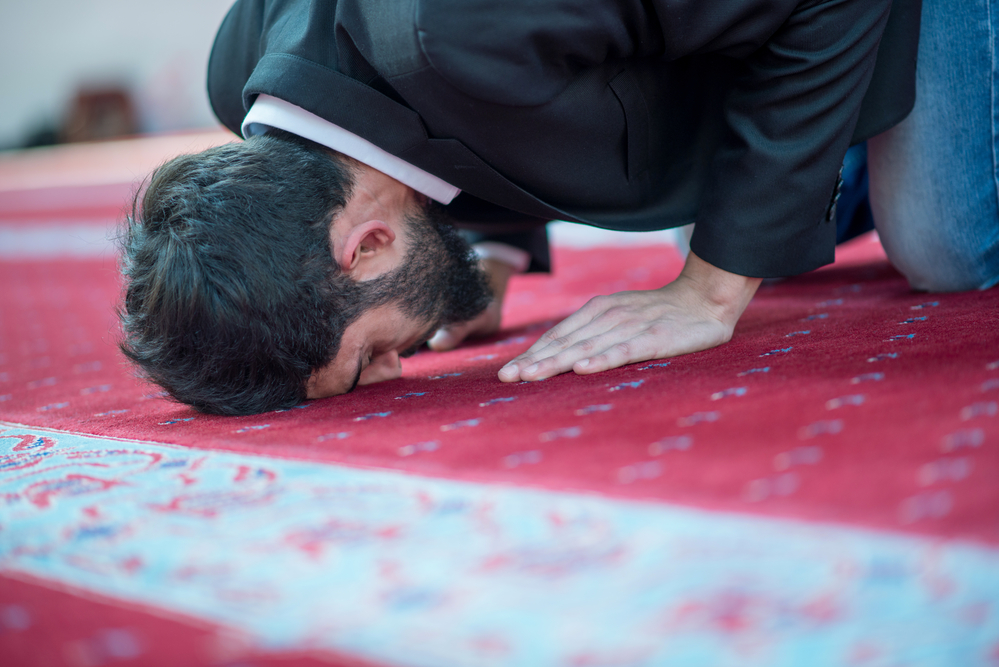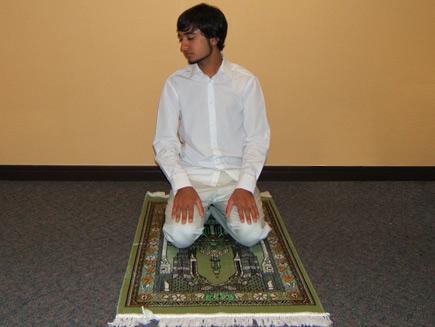- For types and times of 5-daily prayers in Qur’an, go here.
- For the 2 rak’ah Fard (obligatory) minimum possible part of prayer in Qur’an, go here.
Contact Prayer or Salah is n essential good act of all believers. Contact Prayer according to the Quran was ordained on previous generations but they ‘lost it,’ and then it was re-issued in a revised version via the prophet of Islam Muhammad (upon him be peace).
Quran 19: 58. Those were the ones upon whom Allah bestowed favor from among the prophets of the descendants of Adam and of those We carried [in the ship] with Noah, and of the descendants of Abraham and Israel, and of those whom We guided and chose. When the verses of the Most Merciful were recited to them, they fell in prostration and weeping. 59. But there came after them successors who neglected prayer and pursued desires; so they are going to meet evil.
Quran Surah Mariam Vs 58-59
Do you not see that Allah is glorified by all those in the heavens and the earth, even the birds as they soar? Each ˹instinctively˺ knows their manner of prayer and glorification. And Allah has ˹perfect˺ knowledge of all they do.
Quran Surah Nur 24:41
Descriptions of earlier contact prayers observed by past prophets and messiahs can be found in the Bible and other ancient texts. See: http://understandingchrist.com/worship-in-the-bible-not-prayer/
There are 5 daily ordained prayers and between those voluntary prayers may be observed during most intervals.
For Prayer Times: https://www.islamicfinder.org/
How to Pray
Before the prayer, the Iqama or/and adhan is called depending, then the Salah is observed as written below:
| Having cleansed yourself by Wudu (ablution), you may proceed to perform Salah. Wudu is a ritual cleansing. Before you begin your Salah, however, you must make sure that you have a clean body, a clean place to pray, and that you are wearing clothing free of impurities. The minimum clothing required during Salah is: A. For males: Any clothing that covers from the naval to the knees. It is preferable to cover the shoulders. B. For females: Any clothing that covers all of the body (including the head) except the face, hands, and according to Imam Abu-Hanifah the toes and a portion of the front of the feet. The way to offer Salah is: |
| 1. Stand upright facing the direction of Al-Ka’bah. This position is called Qiyaam and the direction is called Qiblah in Arabic. The Qiblah in North America is towards the east with a slight angle towards the north. 2. Make Niyyah (intention) in your heart for the prayer you want to pray. 3. Raise your hands to your ears and say: “Allahu Akbar.” This means: (Allah is the Greatest). This is called Takbiratul Ihram |
Recite, [O Muḥammad], what has been revealed to you of the Book and establish prayer. Indeed, prayer prohibits immorality and wrongdoing, and the remembrance of Allāh is greater / and is for the proclamation of Allahu Akbar. And Allāh knows that which you do.
Quran Surah Al-Hashr 29:45

| 4. Now place your right hand on top of your left hand on the chest and look downward to the place where your forehead will touch the ground in the Sujood (prostration) and recite silently: |

| “Subhanaka allahumma wa bi hamdika wa tabara kasmuka wa ta’ala jadduka wa la ilaha ghairuka.“ سبحانك اللهم و بحمدك، وتبارك اسمك، و تعالى جدك، ولا إله غيرك This means: “O Allah, how perfect You are and praise be to You. Blessed is Your name, and exalted is Your majesty. There is no god but You.” [Only recite this supplication, Subhanaka, at the beginning of the first Rak’ah] Then recite silently: “A’udhu billahi minash shaitanir rajim.” أعوذ بالله من الشيطان الرجيم This is called Ta’awwudh, and it means: “I seek shelter in Allah from the rejected Satan.” بسم الله الرحمن الرحيم [As a beginner, you can just start here>] Then recite: “Bismillahir rahmanir rahim.” This is called Tasmiyah, and it means: “In the name of Allah, the most Gracious, the most Merciful.” 5. After this, recite Suratul Fatihah (the opening chapter) of the Noble Qur’an: “Al hamdu lil lahi rabbil ‘alamin. Arrahmanir rahim. Maliki yawmiddin. Iyyaka na’budu wa iyyaka nasta’in. Ihdinas siratal mustaqim. Siratal ladhina an’amta’alaihim, ghairil maghdubi’alaihim wa lad dhallin. (Amin)“ << الحمد لله رب العالمين، الرحمن الرحيم، مالك يوم الدين، إياك نعبد < وإياك نستعين، اهدنا الصراط المستقيم، صراط الذين أنعمت عليهم غير المغضوب عليهم ولأ الضا لين > This means:”All praises and thanks be to Allah, the Lord of the worlds, the most Gracious, the most Merciful; Master of the Day of Judgment. You alone we worship, from You alone we seek help. Guide us along the straight path – the path of those whom You favored, not of those who earned Your anger or went astray.” You must recite Surat Al-Fatihah in each unit (Rak’ah) of the prayer, if you pray alone. However, if praying behind an Imam and he recites loudly, then it is not necessary for you to recite it. [“And certainly, We have given you seven of the oft-repeated [verses] and the great Quran” Quran Surah Al-Hijr 15:87] 6. Now recite any other passage from the Noble Qur’an. For example: “Bismillahir rahmanir rahim Qul hu wal lahu ahad, allahus samad, lam yalid wa lam yulad, wa lam ya kul lahu kufuwan ahad.“ < بسم الله الرحمن الرحيم >< قل هوا لله أحد،الله الصمد، لم يلد و لم يولد، و لم يكن له كفوا أحد > This means:“In the name of Allah, the most Gracious, the most Merciful. Say, He is Allah, the One. Allah is Eternal and Absolute. He begets not, nor was He begotten. And there is none co-equal unto Him.” |
| 7. Now bow down saying: “Allahu Akbar” and place your hands on your knees and say silently: “Subhana Rabbiyal Adhim.” This means: (How Perfect is my Lord, the Supreme) three times. This position is called Rukoo’. Keep your head in line with your back, and look downward to the place of Sujood. (See step 9) |


| 8. Stand up from the bowing position saying: “Sami’Allahu liman hamidah“ (Allah hears those who praise Him)“Rabbana lakal hamd.” This means: (Our Lord, praise be to You). |

| 9. Prostrate on the floor saying: “Allahu Akbar” with your forehead, nose, palms of both hands, your knees, and toes all touching the floor. Then recite silently: “Subhana Rabbiyal A’la.”(How Perfect is my Lord, the Highest) three times. This position is called Sujood. Keep your arms away from the sides of the body and the ground. |



| 10. Sit up from the floor saying Allahu Akbar. Sit upright with your knees bent and palms placed on them and say: “Rabbighfir li.” رب اغفر لي This means: “O my Lord! Forgive me.” Say “Allahu Akbar” and again prostrate in the Sujood position. Recite “Subhana Rabbiyal A’la” three times. Sit up from this position saying “Allahu Akbar“ |

| This completes the first Rak’ah or unit of Salah. Now stand up for the second Rak’ah and perform it in the same way, except that you do not recite Subhanaka at the beginning, and after the second Sujood (prostration) you sit on the left leg while keeping the right foot upright and put your right hand on the right thigh, with all fingers together in a fist except the index finger. Stick the index finger straight out. Put your left hand on the left thigh. Now recite Tashahhud silently: |

التحيات لله والصلوات والطيبات، السلام عليك أيها النبي ورحمة لله
وبركاته، السلام علينا و على عباد الله الصالحين، أشهد أن لا إله إلا الله، وأشهد أن محمدا عبده و رسوله.
“At-Tahiyyatu lillahi This means: “Greetings, prayers and
was- Salawatu wat-Tayyibatu. goodness belong to Allah.
As-Salamu ‘ alaika Peace be on you,
ayyuhannabiyyu O Prophet
wa rahmatullahi and the mercy of Allah
wa barakatuhu. and His blessings.
Assalamu ‘alaina wa’ala Peace be on us and on
ibadil-Lahis -Salihin the righteous servants of Allah
ash hadu al-La ilaha I bear witness that
il-Lal lahu there is no god but Allah,
wa ash hadu anna and bear witness that
Muhammadan abduhu Muhammad is His servant
wa rasuluhu.” and Messenger.”
In a three-Rak’ah Salah (as in Maghrib) or a four-Rak’ah Salah (Dhuhr, Asr, and Isha) you stand up for the remaining Rak’ah(s) after you have done Tashahhud. For a two-Rak’ah Salah you remain seated after Tashahhud and then recite silently Assalatul-Ibrahimiyah [As a beginner, you can just go to the end salama from here and skip this next part]:
اللهم صل على محمد وعلى آل محمد، كما صليت على إبراهيم وعلى آل إبراهيم، وبارك على محمد وعلى آل محمد، كما باركت على إبراهيم
وعلى آل إبراهيم، في العالمين إنك حميد مجيد.
“Allahumma salli ‘ala Muhammadin “O Allah, let Your mercy come upon Muhammad
Wa ‘ala ali Muhammadin and the family of Muhammad
Kama sallaita ‘ala Ibrahima as You let it come upon Ibrahim
wa ‘ala ali Ibrahima and the family of Ibrahim
wa barik ‘ala Muhammadin O Allah, bless Muhammad
wa ‘ala ali Muhammadin and the family of Muhammad
Kama barakta ‘ ala Ibrahima as You blessed Ibrahim
Wa ‘ ala ali Ibrahima and the family of Ibrahim.
Fil a’lamina Innaka Truly You are
hamidun Majid.” Praiseworthy and Glorious.”
After this say silently: “Allahumma inni a’udhu bika min adhabi jahanam wamin adhabil qabri wamin sharri fitnatil mahya wal mamat wamin sharri fitnatil masihid dajjaal. Rabbi-ghfir li waliwalidayya, rabbi-rhamhuma kama rabbayani saghira.”
اللهم إني أعوذ بك من عذاب جهنم، و من عذاب القبر، و من فتنة المحيا و الممات، و من فتنة المسيح الدجال، رب اغفر لي و لوالدي رب ارحمهما كما ربياني صغيرا.
This means: “O Allah! I seek refuge in You from the torment of the Hellfire, from the torment of the grave, from the trials and afflictions of life and death, and from the deception of the False-Christ. O my Lord! Grant me and my parents forgiveness, and bestow Your mercy upon them, just as they brought me up when I was small.”
| 11. Salama: Now turn your face to the right saying: “Assalamu alaikum wa rahmatullah” (peace and the mercy of Allah be on you) and then to the left repeating the same words. |

| This completes the two-Rak’ah Salah. In the three or four-Rak’ah prayers (Dhuhr, Asr, Maghrib, and Isha) the whole procedure is repeated in the remaining Rak’ah(s), except after Tashahhud, you say “Allahu Akbar” and stand up and only recite Surat Al-Fatiha in Fard prayers and no other Surah, then continue doing the rest of the actions as you have done before (Rukoo’, rising, Sujood). Then stand again for the fourth Rak’ah. Also, in the last Rak’ah of any prayer, after you have made your Sujood, sit up and silently recite both Tashahhud and Salatul Ibrahimiyyah. At the end of any prayer, you must finish by making Tasleem. When to Recite Aloud or Silently:During obligatory Fajr prayers, you recite the Qur’an aloud in both Rak’ahs. You also recite the first two Rak’ahs of the obligatory prayers of Maghrib and ‘Isha aloud as well. However, the third and fourth Rak’ahs are always recited silently during obligatory prayers. Also, in the Dhuhr and Asr prayers, the recitation is always silent for all four Rak’ahs. Furthermore, the one who leads Jumu’ah prayers (Friday prayer in place of Dhuhr) will recite the Qur’an aloud. |

Source: https://raleighmasjid.org/how-to-pray/salah.htm
For more summative details on how to pray, and other ways to perform ablution, please go here: https://raleighmasjid.org/how-to-pray/index.htm
Prayer in the Bible
And he(Jesus) went a little further, and fell on his face, and prayed, saying, O my Father, if it be possible, let this cup pass from me: nevertheless not as I will, but as thou will.
Matthew 26:39
Then the LORD opened the eyes of Balaam, and he saw the angel of the LORD standing in the way, and his sword drawn in his hand: and he bowed down his head, and fell flat on his face.
Numbers 22:31
Nehemiah 8:5. Ezra opened the book. All the people could see him because he was standing above them; and as he opened it, the people all stood up. 6. Ezra praised the LORD, the great God; and all the people lifted their hands and responded, “Amen! Amen!” Then they bowed down and worshiped the LORD with their faces to the ground.
Nehemiah 8:5-6

More: http://understandingchrist.com/worship-in-the-bible-not-prayer/
Jewish Prayer
Refer to a Jewish foremost book on prayers, TO PRAY AS A JEW; by Rabbi Hayim Halevy Donim


Read more: https://submission.org/Jews_pray_like_Muslims.html
Also Prayer in Ancient Egypt
View: Pa Ashutat – “The Prayer” on Amazon: https://www.amazon.com/Pa-Ashutat-Dr-Malachi-York/dp/B0012TXLSQ



